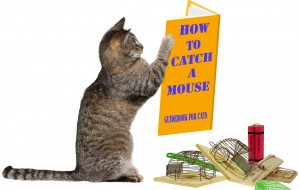The other day I was at a lunch party and a friend who had just moved to town said “I believe we are going to be calling you soon”. When you work in the pest industry this type of statement is code for ‘we have a problem we do not know how to solve’.
I asked what the problem was. They have a mouse problem. There is a mouse that has set up a nice little life in their kitchen going from one area of the cabinets to the other area snacking on the food crumbs their two (almost 3) children leave behind. So many mouse issues can be handled by knowing how to properly set up and operate a common mousetrap. That being said, always follow the safety and label instructions from the manufacturer for the traps purchased.
How to Properly Set a Mousetrap
 Buy some spring loaded mouse traps. You can get the pre-scented ones or the old school metal ones which you have to put your bait onto the trap.
Buy some spring loaded mouse traps. You can get the pre-scented ones or the old school metal ones which you have to put your bait onto the trap.- Determine the trail that the mouse, or mice, are using. More often than not they are coming into, or hiding in, the house from a specific spot and run around the house on a trail they have done before. Mouse droppings can be a good indicator of this trail. You can expect that they will be run this route many more times.
- Put the bait onto the mousetrap, peanut butter is an attractive choice because the mouse will tend to push on the trap more, thus setting it off. If you have a big piece of cheese on there the mouse might be able to pull the cheese off without setting off the trap, or being close enough to cause harm if the trap goes off.
- Pull the spring back to it’s ready position and holding it in place with a thumb or palm.
- Take the holding bar over the spring and clip it under it’s holding spot on the trap. With the standard metal traps where you put your bait on there is a little notch to hook the bar under. This will hold the trap in ready position until the metal bait holder is jostled. If you have a pre-scented trap, then the plastic scented piece has a holding notch as well, it just looks a bit different.
- Place the trap perpendicular to the wall, with the bait side closest to the wall. Mice, rats, spiders, etc. will always run around your house along the walls. This gives some added level of protection to them. So when identifying the trails that a mouse uses it should indicate near a wall. Putting the trap perpendicular to the wall gives two sides for the mouse to hit the trap. If you put the mouse trap parallel to the wall then it hits the bait when encountering the trap from one side, but the other side it might just set off the trap, but not be in a position to actually get caught by the trap.
- Check the traps periodically, at least weekly, especially if you have a perishable bait on them. Put that thumb or palm over the spring latch to keep it from snapping on you then manually disable the trap. From there clean off and re-bait the trap, setting it up in a new area if desired.
- Use a plastic bag to remove the dead animal. You do not want to incur any fleas or germs that might be on the mouse’s body. Discard the trap with the animal. The good thing with mouse traps, they are very inexpensive.
Hopefully, you will find that spooky little mouse dead as soon as your first check on your traps. If not do not be discouraged, just keep setting them properly and in well traveled areas for the mouse and eventually you will get them. If you just can’t seem to capture the mouse in your house, give the rodent control experts at Johnson Pest a call!
Need Help Setting a Mousetrap?
How to Properly Set a MouseTrap in Sevierville TN?
Serving Sevier County and surrounding areas since 1984